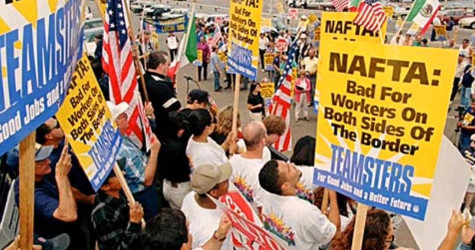Budget 2008: Taxes and the Forward March of Neoliberalism
Budgets are fundamentally political instruments. They reflect clearly who in society is winning, who is losing, and who is left standing still. They are a kind of political scoreboard. Canada’s 2008 Federal Budget, introduced by the minority Conservative government of Prime Minister Stephen Harper on February 26th, clearly states that if you work for a low or modest wage or salary, live in an urban centre, are women or a member of our First Nations, then you have lost. If you have sufficient income to generate small savings you are holding your own, and if you are part of the professional and capitalist classes in Canada, particularly financial capital, the neoliberal victory march continues.
Finance Minister Jim Flaherty boasted that his consecutive third budget reduced tax levels to what they were fifty years ago in the Diefenbaker era. This projected a sentimental yearning for a time when Canadians paid privately for such services as health care and post-secondary education, when public transit was peripheral, and when getting tough on crime included capital punishment. This was the zeal of Ontario’s Common Sense Revolution of the 1990s when Flaherty was a minister of that provincial government, and played a key role in gutting the fiscal and administrative capacity for redistributional policies of the Ontario state. Flaherty and Harper have sought to recreate key aspects of this model at the national level.
Neoliberalism and the Tax Cuts Agenda
The Conservatives have done so particularly by generalized tax cuts and breaks that seek to build populist support behind their project of a smaller welfare state, expanded military and law and order government. This budget continues the largest tax giveaways in Canadian history that began with Flaherty’s first budget in May 2006. Although the corporate subsidies will continue, particularly for the defence and nuclear energy sectors, and some smaller special measures for manufacturing industries, the Conservative emphasis is on generalized corporate and personal tax breaks. This is a core neoliberal position: who needs a subsidy when you simply don’t have to pay tax? This, of course, works well for corporations with sufficient cash flow for reinvestment and individuals with income to save “surplus” money. Budget 2008 was billed as “Responsible Leadership” and it certainly was for those it will benefit. However, for the vast majority of Canadians there is not much here.
The media has characterized Budget 2008 as “disappointing”, “prudent”, and “modest”. But this clichéd commentary misses the implications of the proposals. In particular, the pundits simply neglect the extent to which Budget 2008 deepens the erosion of public finances in Canada. The budget is the latest installment of a process for dismantling Canada’s rather modest welfare which began in earnest with the Chrétien-Martin Liberals in the mid-1990s.
There are two central themes which form the base of Budget 2008.
The first is the further erosion of the tax base to finance public services. This strategy is referred to in the Budget as “Strengthening Canada’s tax advantage. Since Flaherty’s Economic Statement of October 2007, the Conservatives have committed to $60 billion in tax cuts through to 2012. Since 2006, the Federal debt has been reduced by $37 billion. The tax cuts in combination with aggressive use of budget surpluses to reduce debt are not simply an accounting tactic. It is the main Conservative economic strategy to preclude a future government from initiating new programs such as child care, pharmacare, or an urban and infrastructure agenda, without initiating new tax increases.
Within this framework of making cuts in revenue sources, there is the further objective of reducing corporate tax levels. The Conservative plan is to drop the rate of corporate income tax to 15.0% by the year 2012 from the current rate of 19.5%. If this goal is achieved, the Conservatives will have reduced corporate taxes by a full third since coming into power in 2006. The result is that Canada will have the lowest corporate tax rate in the G7 group of countries. This is even lower than what corporations pay in the United States, and quite contrary to the rhetoric of the business media and the Conservatives of Canada imposing high taxes on capital. These cuts are in addition to the elimination of the corporate surtax effective January 1st of 2008. It is sheer rhetoric from the corporate sector that the Conservatives are not doing enough to aid business. These cuts are occurring at a time when the Conservatives acknowledge that “the financial position of the corporate sector is very healthy. Corporate profits as a share of GDP are near their record high, well above average historical levels.”
In December 2007, Flaherty noted that “real income per capita has risen over 20% since the end of 2001”. Canada is ranked as the eighth largest economy in the world. But all this says nothing about distribution. Despite a 33 year record low unemployment rate real wages have been stagnant for 30 years while corporate profits have never been higher. The Canadian Centre for Policy Alternatives notes: “A decade of personal income tax cuts, such as reduced taxation of capital gains on income and stock options, have favoured high-income earners” (CCPA 2008 Alternative Budget). The Conservative’s 2008 Budget only serves to allow more wealth to accrue to those who need it least.
The Conservatives no doubt understood that low and middle income Canadians would quickly come to understand that this budget meant precious little to them. Some market populism was necessary to better politically market the program of flowing resources to the professional and capitalist classes. The Tax-Free Savings Account (TFSA) offered in the budget is meant to suggest that the Conservatives are equal opportunity tax cutters. Beginning in 2009 Canadians will be eligible to contribute up to $5,000.0 per year to such an account and any interest or capital gains from this account will be tax free. It’s an interesting proposal in that it extends the tax avoidance movement into more popular terrain. The contribution limit makes it appear that this is clearly not aimed at high-income earners. However, for the 40 per cent of working Canadians who earn $40,000 per year or less, the prospect of saving anything is rather dubious. Instead, the TFSA will be precisely another tax shelter “toy” for those with sufficient income to allow for disposable income. Indeed, for a high income earner able to sock away $5,000.00 per year for say, 8 years, there will be a nice tax free bundle of approximately $50,000.00 for a down payment on an imported luxury car. When it’s all said, this is really a tax avoidance instrument through which to shelter one’s play-time money.
The other significant tax giveaway is the rather more complex Capital Cost Allowance (CCA). In the 2007 Budget this was introduced to allow businesses to rapidly depreciate the value of new assets such as equipment, technologies etc. against their annual tax bill. This has now been extended by three years. The cost to the government in the form of lost revenue will be approximately $1 billion by the end of 2013. The intention is to spur the purchase of new assets given that their cost can be to a significant degree written off against corporate taxes which as we have already seen are falling like a stone. Again what this amounts to is a form of corporate welfare where tax dollars that could be used for public services are instead used to transfer money between businesses. Accelerated CCA’s have been the industrial policy of choice for Canadian governments for decades, and neoliberals particularly favour such measures for avoiding government intervention into industry. But this strategy has consistently failed to address the faltering productivity performance of Canadian industry, or the decline of manufacturing capacity.
Building the Market
A second major theme of Budget 2008 is the use of the state to support the “free market” by undermining the interests of workers and advancing the interests of capitalists. While neoliberals like Flaherty and Harper attempt to fiscally handicap the use of the state for redistributional measures, they are quite capable of strengthening the state for military interventions and law and order as well to advance their particular political projects. The Conservative budget proposes to create two new crown corporations, each with one of these agendas. The first of these is the creation of the Canada Employment Insurance Financing Board (CEIFB). The details are far from known at this time, but the stated purpose of this new entity will be to ensure that Employment Insurance (EI) premiums are not simply used as funds to generate budgetary surpluses. Any EI surplus will be directed toward supporting EI programs. That is long overdue. However, this does nothing to address the serious question of benefit sufficiency and accessibility. That only 42% of Canadian workers are actually eligible to draw on EI benefits is a farce of the highest order. In this restructuring of the administration of the EI system, the future is no doubt one where funds will be more closely linked to workers being relocated and required to participate in training programs for jobs which don’t exist or are sub-standard. In other words, the CEIFB will be an instrument to poke and prod the unemployed more efficiently, while providing the government a degree of insulation from the policies.
The other new crown corporation – PPP Canada Inc. – is mandated to expand the role of the for-profit private sector in the provision of infrastructure through the use of what are referred to as “public-private partnerships”, hence the three ‘P’s. Over the next two decades Canada will have to spend up to an estimated $300 billion on highways, water and sewage systems, bridges, air and rail transportation infrastructure. PPP Canada will direct and manage the creation of a market for these projects and ensure a place for profit-making corporations (corporations in effect earning tax dollars while paying little tax). As with all P3’s, there will be a great deal of corporate subsidization as the corporations involved absorb very little risk. The contracts will be set with a great deal of space for “cost plus profit margin” guarantees, and governments will be there to pick up the pieces if the corporations bail-out (also a common feature of P3’s, the so-called “moral hazard” dilemma). In the hospital sector, where a number of public-private partnerships have been introduced, the result has always been not private sector efficiency but dramatic cost over-runs and delay. P3’s are often no more than a guaranteed income program for corporations and their investors.
A third example of state power actually being expanded relates to new spending on security and defence. Budget 2008 proposes a “Canada First Defence Strategy” which has two objectives. First, it establishes an automatic annual defence spending escalator set at 2 per cent. This is to say that the defence budget will increase by a guaranteed 2 per cent every year. It’s estimated that this alone will, over 20 years, add an additional $12 billion to the defence budget. The second objective is to link corporate Canada more closely to defence spending. A “new relationship with industry” is sought as a means to build a Canadian military-industrial complex and again transfer public dollars to private hands. Militarization is packaged as economic development and soon a career in the armed forces will be more widely seen as a route to career advancement unto itself and in the defence industries. When we consider that defence spending today stands at $18 billion, the highest it has been since the Second World War.
In addition to defence spending guarantees, this budget invests more than $700 million in law and order and security measures. There is, for example, $400 million alone for 2,500 more police. Various proposals totaling more than $160 million are ear marked to improve border security. And most curiously, an entity with the enigmatic name of “Communications Security Establishment” is provided an additional $43 million to better intercept and decode communications.
For a neoliberal party dedicated to reducing the role of the public sector in people’s lives, the Conservatives are proving quite adroit at using the state to build the market and advance capitalist interests.
Political Stalemate
This neoliberal budget is remarkable in how much it ignores severe problems in the manufacturing sector, an over-valued dollar, expanding job insecurity and income polarization, and fiscal problems in the health and university sectors. The Conservative government is doing almost nothing to aid Canada’s working families and communities. Instead, the financial sector and professional classes who have done the best over the past decade have been further rewarded. To those who have much, much shall be given.
Notwithstanding a ritual round of criticism from the opposition parties, Budget 2008 will pass. The Liberals under Chretien-Martin proved to be quite adept at implementing neoliberal policies. Under new leader Stéphan Dion they are quite vacant of policy alternatives and politically tentative on virtually all the major issues of the day for fear of an election and being exposed as dissenting from the neoliberal consensus. The Liberals will either walk away from the budget vote in the House or engineer an anemic display of opposition. The Bloc Quebecois has been voicing more vigorous opposition, after more than two years of playing cozy with the government, but their reform agenda has become almost impossible discern except for increasing powers to the provinces at whatever the moral cost. The New Democrat Party has been the clearest opposition to the budget, after spending most of the last years of minority governments by the Liberal and Conservatives of trying to leverage minor policy favours while sacrificing principled opposition. This has been the pragmatism and “fresh” thinking Jack Layton has brought to the federal NDP. It is has left the NDP drifting, with no one certain what their policies are, and no particular relationship being the social movements or the political struggles of workers. One Federal NDP by-election candidate is organizing under the empty slogan of “embrace the orange”, the pathetic and politically empty used by the NDP in the last Ontario campaign. It is anybody’s guess what their electoral fate will be. Canadians are presented with the disheartening spectacle of three major opposition parties which have nothing really to say in the face of the most hardened neoliberal government, at war and at one with the American leadership, Canada has ever confronted. What more evidence is needed for progressives and socialists in Canada, in unions and social movements, to begin to explore political alternatives? Change, anyone?





